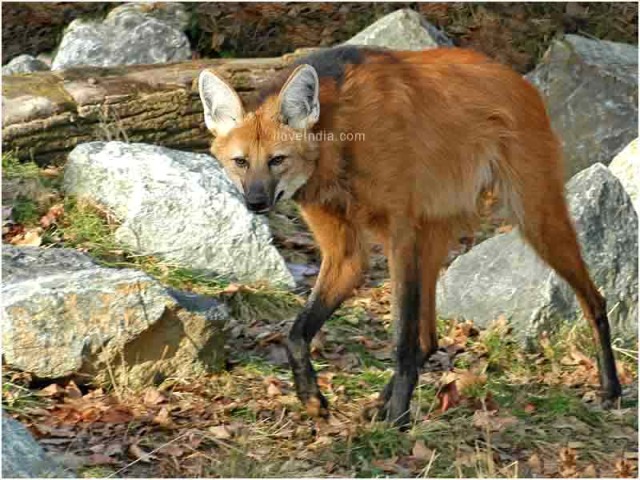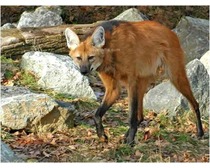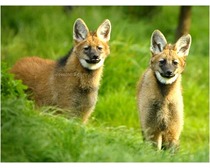Maned wolf belongs to dog family, but seems to have inherited its features from red fox. Read on to find some more interesting facts and amazing information on the maned wolves.
Facts About Maned Wolf
Maned wolf, with the binomial name Chrysocyon brachyurus, is the largest canine species in South America. It looks like a big fox in some ways, but is a member of dog family. It is often known as ‘red fox on stilts’, due to the color of its fur (orangish-brown to golden orange) that it shares with the red fox and its extremely log black legs, which make it look as if the animal is standing on stilts. The long legs are probably adapted to the tall grasslands of its native habitat. Its name maned wolf is based on its characteristic black mane, which can be erected along the back. The animal possesses large triangular ears, distinctive long tail and big nose. The survival of this stunning animal is threatened and hence, it is classified as "Vulnerable" in the IUCN Red Data Book. Read on to know some more interesting facts and amazing information on maned wolves.

Facts About Maned Wolf
Kingdom: Animalia
Phylum: Chordata
Subphylum: Vertebrata
Class: Mammalia
Order: Carnivora
Family: Canidae
Subfamily: Caninae
Genus:Chrysocyon
Species: C. brachyurus
Height: 1 m (3.3 ft)
Weight: 20 to 25 kg (44 to 55 lb)
Life Span: Approximately 15 years
Diet: Rodents, other small mammals, birds, reptiles, insects, fruit, and other vegetable matter
Range: Central and Eastern Brazil, Eastern Bolivia, Paraguay, Argentina, and Uruguay
Habitat: Grasslands, savannahs, and swamps
Age of Sexual Maturity: 365 days (males); 730 days (females)
Gestation Period: 62-66 days
Number of Offspring: 2 to 6 black-furred pups
Interesting & Amazing Information On Maned Wolves
- Maned Wolf is an astonishing animal, native to South America, with physical features of a hyena, the head and coat color of a wolf and the large ears of an African hunting dog.
- The animal forms a monogamous pair and exhibits a solitary lifestyle. In pairs, it might defend a shared territory of about 30 square km.
- Male and female wolves typically associate in breeding season only, which begins in the month of April.
- The female maned wolf gives birth to 2 to 6 pups and does not depend on her partner to bring them up. However, males help raise pups byreiterating food until they are 10 months old in captivity.
- The long legs of this specie enables it see above tall grass, making easy for the animal to spot prey as well as hide from it.
- Both male and female maned wolves use their urine to communicate, like marking the hunting paths and burying of the hunted prey.
- The animal uses its sharp teeth to dig inside its prey, instead of using the claws. It further bites the prey on the neck and back and shakes it violently, if necessary.
- Maned wolf does not form packs; rather it prefers to hunt alone.
- It is a nocturnal animal that hunts for its prey between sundown and midnight and prefers to rest under forest cover during the day.
- The animal is an extremely stunning canid, owing to its physical features and conspicuous way of moving.
- Maned wolf has a distinctive odor, which has given it the nickname of ‘skunk wolf’ as well.
- It is a very shy animal, which flees when alarmed and attack humans only when it feels threatened or afraid.
- Amongst the locals, maned wolf is believed to have supernatural powers. Its right eye is supposed to bring luck in gambling.
- Another superstition has it that if children wear a necklace having a maned wolf tooth, they will not have dental problems in future.
- The animal’s fur is used for making amulets as well as in religious ceremonies, by the native South American inhabitants.


See also
More from iloveindia.com
- Home Remedies | Ayurveda | Vastu | Yoga | Feng Shui | Tattoos | Fitness | Garden | Nutrition | Parenting | Bikes | Cars | Baby Care | Indian Weddings | Festivals | Party ideas | Horoscope 2015 | Pets | Finance | Figures of Speech | Hotels in India : Delhi | Hyderabad | Chennai | Mumbai | Kolkata | Bangalore | Ahmedabad | Jaipur
- Contact Us Careers Disclaimer Privacy Policy Advertise With Us Lifestyle Sitemap Copyright iloveindia.com. All Rights Reserved.





